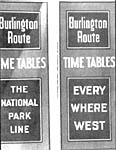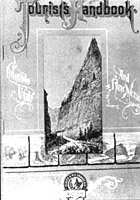|
|
Fake
Railroad Paper
Railroad paper has become a hot collectible in recent years, with some
timetables and brochures going for many hundreds of dollars. Some rare
passes have gone for even more. So in a familiar pattern, this type of
collectible has now become more susceptible to deception and counterfeiting.
One of the inherent problems with railroad paper is that it is easy
to reproduce, and many historical associations have done so with the
best of intentions. Such reproductions can convey valuable information
to collectors and historians who might not otherwise have access to the
originals. Fortunately many of these reproductions have been marked as
such, although there is always the possibility that these markings can
be removed or camouflaged. Following is information on known reproductions
of railroad paper. Bear in mind that this is not anywhere near an exhaustive
list. We especially thank Bill and Sue Knous who generously gave permission
to reproduce images and text from their book
on counterfeit railroad collectibles.
  The
pass at right -- Denver & Rio Grande Railway 1872 Annual Pass, issued
to Mr. J.L. Sanderson on account of Frontier Overland Mail Co. -- is
a reproduction made as a giveaway for a bank anniversary celebration
in 1972. The one and only original is owned by a museum. This reproduction
has sold for as much as $400. The
pass at right -- Denver & Rio Grande Railway 1872 Annual Pass, issued
to Mr. J.L. Sanderson on account of Frontier Overland Mail Co. -- is
a reproduction made as a giveaway for a bank anniversary celebration
in 1972. The one and only original is owned by a museum. This reproduction
has sold for as much as $400.
 The following
list of employee & public timetables were reproduced by the Colorado
Railroad Museum. All of these items have been permanently marked as reproductions
but also may be easily misrepresented. Special thanks to the museum for
compiling this list. The following
list of employee & public timetables were reproduced by the Colorado
Railroad Museum. All of these items have been permanently marked as reproductions
but also may be easily misrepresented. Special thanks to the museum for
compiling this list.
EMPLOYEE TIMETABLES
ATCHISON TOPEKA & SANTA FE NEW MEXICO DIV. 56,8/30/31
COLORADO & SOUTHERN GEORGETOWN LOOP 6/3/1904
COLORADO & SOUTHERN NORTHERN DIV. 56, 6/6/1920
COLORADO & SOUTHERN SOUTH PARK DIVISION 17,10/15/1910
COLORADO & SOUTHERN DENVER TERMINAL DIV. 9, 5/15/1924
COLORADO SPRINGS & CRIPPLE CREEK DISTRICT 1, 7/15/1919
COLORADO MIDLAND (AT&SF) #66,1/1/1895
COLORADO MIDLAND #2 11/18/1917
COLORADO & WYOMING #1 7, 5/30/1909
DENVER & INTERMOUNTAIN #20, 3/l/43
DENVER & INTERMOUNTAIN #23,3/10/46
DENVER & INTERURBAN #5, 5/27/1923
DENVER BOULDER & WESTERN #10, 6/29/1913
DENVER NORTHWESTERN & PACIFIC #1, 6/23/04
DENVER NORTHWESTERN & PACIFIC #31, 7/l/1911
DENVER & RIO GRANDE #1 9, 7/23/1882
DENVER & RIO GRANDE 3RD DIVISION #99, 7/20/1919
DENVER & RIO GRANDE 3RD DIVISION #100, 3/28/1920
DENVER & RIO GRANDE 4TH DIVISION #1 02, 7/20 1919
DENVER & RIO GRANDE 4TH DIVISION #104,1/29/1922
DENVER & SALT LAKE #1 9, 7/6/1919
DENVER SOUTH PARK & PACIFIC (UNION PACIFIC) #4,1/11/1883
PUEBLO UNION DEPOT #203, 4/13/1913
RIO GRANDE JUNCTION #1 06, 7/20/1919
RIO GRANDE SOUTHERN #57, 6/18/1911
RIO GRANDE SOUTHERN #65,7/20/1919
RIO GRANDE SOUTHERN #3, 7/l/1933
UINTAH #27, 12,25, 1938
PUBLIC TIMETABLES
ATCHISON TOPEKA & SANTA FE November 5,1939
CHICAGO BURLINGTON & QUINCY July 8,1928
CHICAGO ROCK ISLAND & PACIFIC 1891
COLORADO MIDLAND December 1902
COLORADO MIDLAND October 1908
COLORADO & SOUTHERN April 1899
DENVER LARAMIE & NORTHWESTERN 10/22/1911
DENVER LEADVILLE & GUNNISON / UP DENVER & GULF, August 1897
DENVER NORTHWESTERN & PACIFIC June 1905
DENVER NORTHWESTERN & PACIFIC June 6, 1912
DENVER & RIO GRANDE August 1890
DENVER & RIO GRANDE / WESTERN PACIFIC July 1915
DENVER & RIO GRANDE WESTERN/ AMTRAK 8/22/82 & 4/24/83
DENVER & SALT LAKE January 16, 1944
DENVER SOUTH PARK & PACIFIC December 1880
FLORENCE & CRIPPLE CREEK June 1896
UNION PACIFIC (SOUTH PARK DIV.) 1880
UNION PACIFIC (NEBRASKA / WYOMING DIVS.) November 1917
UNION PACIFIC January 16,1939
WISHBONE ROUTE (DENVER & NORTHWESTERN) c.1910
 Depot and
Advertising posters have been reproduced, including the following: Depot and
Advertising posters have been reproduced, including the following:
- COLORADO MIDLAND HAGERMAN PASS LITHOGRAPH from the steel engraving
- UNION PACIFIC 1869 poster of the DRIVING OF the GOLDEN SPIKE
- DETROIT PHOTOGRAPHIC colored lithographs of ANIMAS CANYON
 |
 Various
tourist brochures and timetables have been reproduced, including
the Denver & Rio Grande Railroad tourist handbook shown at
right. This reproduction was beautifully done, and its reproduction
status was made apparent only after careful examination. Shown at
left is a 1928 Burlington Route public timetable reprinted in
1992 by the National Railway Historical Society and marked accordingly. Various
tourist brochures and timetables have been reproduced, including
the Denver & Rio Grande Railroad tourist handbook shown at
right. This reproduction was beautifully done, and its reproduction
status was made apparent only after careful examination. Shown at
left is a 1928 Burlington Route public timetable reprinted in
1992 by the National Railway Historical Society and marked accordingly. |
 |
   An
1876 timetable from the Atchison,
Topeka & Santa
Fe Railroad has been recently produced in some quantity.
According to a reputable source, the text does not indicate that
it is a reproduction. We do not know if there ever was an original
timetable that looked just like this, but this version was produced by the An
1876 timetable from the Atchison,
Topeka & Santa
Fe Railroad has been recently produced in some quantity.
According to a reputable source, the text does not indicate that
it is a reproduction. We do not know if there ever was an original
timetable that looked just like this, but this version was produced by the  railroad for the nation's Bicentennial. The Santa Fe issued their 1975 Annual report with this timetable shown on the cover -- shown at right. Click on the image for a larger version. railroad for the nation's Bicentennial. The Santa Fe issued their 1975 Annual report with this timetable shown on the cover -- shown at right. Click on the image for a larger version. |
Some other things to keep in mind:
 According
to Bill and Sue Knous, "The process used for reproducing illustrations
changed tremendously in the 30s with the development of photoengraving.
Halftone engravings are made from photographs, paintings or other copy
that has tones or shades. To reproduce the tones, the photoengraver photographs
the copy through a half tone screen. This screen looks much like a window
screen but is much finer. The screen breaks up the image on the negative
into tiny dots of different sizes. When the illustration is printed,
the viewer's eye blends the dots into duplicates of the original tones.
Under close examination through a high-powered glass the printed screen
is obvious. We urge you to carry a pocket magnifier at all times. Closer
examination of any collectible can pay off many times over. Remember,
with regard to the printing process, if you examine a piece dated 1880
and you see a screen, chances are that it has been reprinted. " According
to Bill and Sue Knous, "The process used for reproducing illustrations
changed tremendously in the 30s with the development of photoengraving.
Halftone engravings are made from photographs, paintings or other copy
that has tones or shades. To reproduce the tones, the photoengraver photographs
the copy through a half tone screen. This screen looks much like a window
screen but is much finer. The screen breaks up the image on the negative
into tiny dots of different sizes. When the illustration is printed,
the viewer's eye blends the dots into duplicates of the original tones.
Under close examination through a high-powered glass the printed screen
is obvious. We urge you to carry a pocket magnifier at all times. Closer
examination of any collectible can pay off many times over. Remember,
with regard to the printing process, if you examine a piece dated 1880
and you see a screen, chances are that it has been reprinted. "
With today's technology, the potential exists for reproducing
paper items like passes and posters. Jim Hutzler suggests the following
characteristics that are more difficult to fake and that would suggest
authenticity:
-
"The pass is made of a type of thick paper or
cardstock (usually more than 1 piece laminated together) often of
a coated type stock not produced today. Corners are perfectly rounded
and cut by a special machine.
-
Printed titles and decorative vignettes are raised
and embossed.
-
Dates are embossed and of a different color, and
printed so that the reverse impression of the date is visible on
the back side.
-
The pass was filled out using a fountain pen. A
trained eye today can examine the printing and signature and determine
that it is (a) filled out with a proper type pen and ink type of
the era (not photo-reproduced) and (b) penned by a hand well versed
in the style of the day.
Some officer signatures on passes from the 1800s (and a majority later)
are printed, and a few of the early notables can be a little deceiving.
Good examples are the Pullman passes with the huge George Pullman signatures
from the 1870s. These were the special series for big-wigs, but all of
this type that I have seen are printed, not an actual signature. Most
paper fakes can be identified as such just by using a little common sense
and historical knowledge."
Update. See separate page of comments sent in by a
collector regarding timetable authenticty.
Comments
or additional information are welcome. See Contact Us page.
Special thanks to Bill and Sue Knous for permission to reproduce text
and images from their book. Also thanks to Jim Hutzler. |